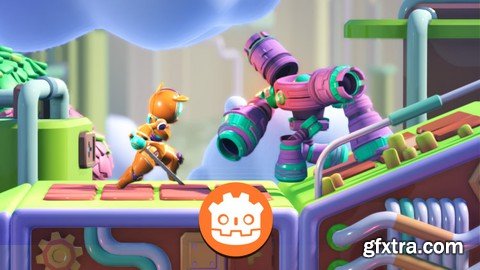
Hello, I’m Single-minded Ryan, a game developer and digital artist. In this course, we are going to create a typical 2D-style game in a 3D world, but before getting into the details, I know you have a big question a ask: What is the code benefit that this course has to offer? The answer is that I want you to feel like you are making a real game from the very beginning I want to you learn the knowledge about game development with production-level game assets, so you can absorb these ideas seamlessly. This is why I put a lot of effort into creating the assets for the course, so you can have high-quality characters, smooth animations, detailed materials and VFX particles, and good-looking level modules to work with. These assets are great benefits you can get with this course because you can use the assets to experiment with new ideas and design your levels even after finishing the course. Let’s talk about what we are going to do in this course. Our player can explore this world with 2D movements, so we’ll cover these behaviors in GDScript, including the run, jump, and melee attack actions. Then we’ll learn how to control the animations using a combination of different animation nodes, such as the StateMachine node, the blend animation node, and the OneShot node. This way you will have more flexibility when dealing with complicated animation setups. When it comes to the enemy, I’ll show you how to make it patrol around the platform, and to detect the edges and blocks so it knows when to turn around. These behaviors are achieved by the ray cast feature, which is an essential technique you have to know to deal with the physics engine in game development. Visual effect is also a big part of video games, I’ll show you how to control the particles via the script and how to create material animation for the sword-swinging action. Want more challenges for the player? Let’s create a trap with spikes, here we’ll learn how to detect physics bodies using a collision shape, and how to use physics layers to manage the collision detection. Need something to keep the player alive? Here comes the health pickup. To make the pickup work, We’ll finish the player’s health system with the heart UI on screen. Finally, we’ll set up an end door as the destination of the level, and cover the game over UI and the restart game button to finish up the gameplay By the end of this course, you’ll be able to export the game to executable files and show it off to your friends. If you are eager to improve your programming skills, this course also has a lot to offer. We’ll talk about the core idea of Godot game development: the Game Lifecycle functions, these concepts are shared between many game engines, so understanding these functions will help you establish a solid foundation for your further career. You’ll learn about some basic programming ideas like how to use variables and constants, how to use conditions and control flow like the if statement and the for loop. We’ll also talk about some unique GDScript features, like how to use annotations and how to communicate between scripts using signals, which is But I want you to notice that this course is not heavily code-oriented, meaning it would be really great if you understood some basic programming ideas. 
Top Rated News
- Sean Archer
- AwTeaches
- Learn Squared
- PhotoWhoa
- Houdini-Course
- Photigy
- August Dering Photography
- StudioGuti
- Creatoom
- Creature Art Teacher
- Creator Foundry
- Patreon Collections
- Udemy - Turkce
- BigFilms
- Jerry Ghionis
- ACIDBITE
- BigMediumSmall
- Boom Library
- Globe Plants
- Unleashed Education
- The School of Photography
- Visual Education
- LeartesStudios - Cosmos
- All Veer Fancy Collection!
- All OJO Images
- All ZZVe Vectors



